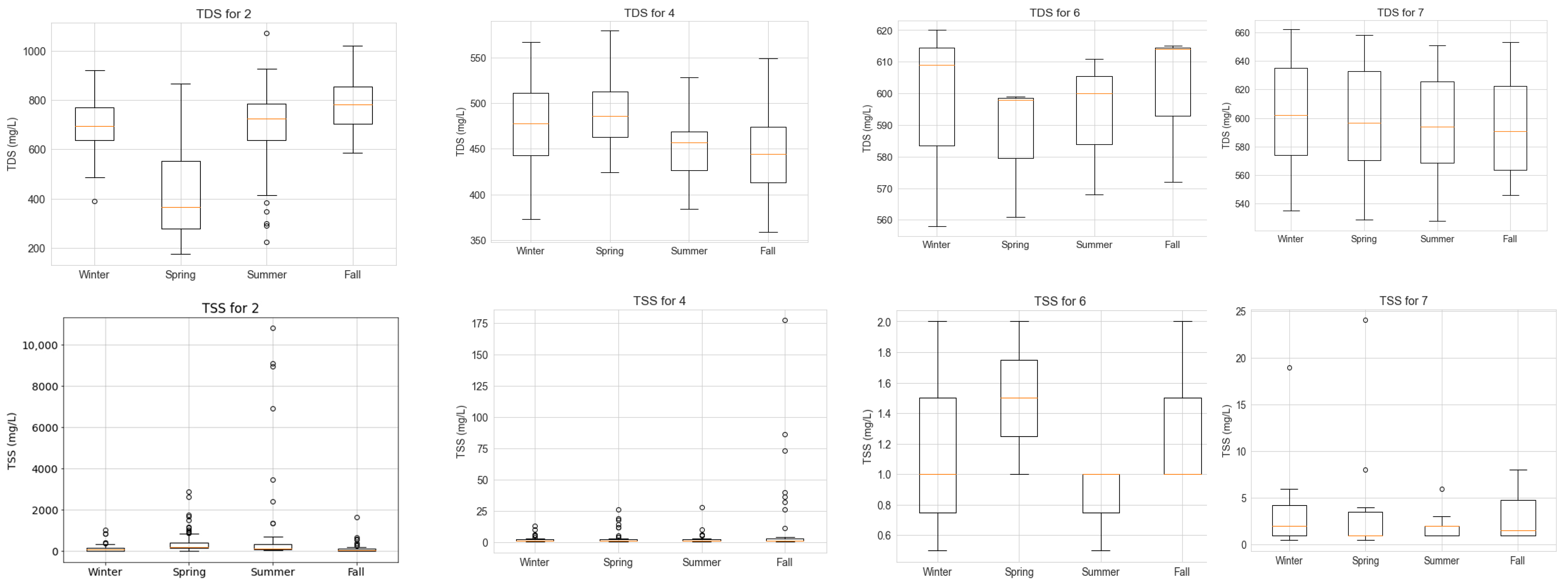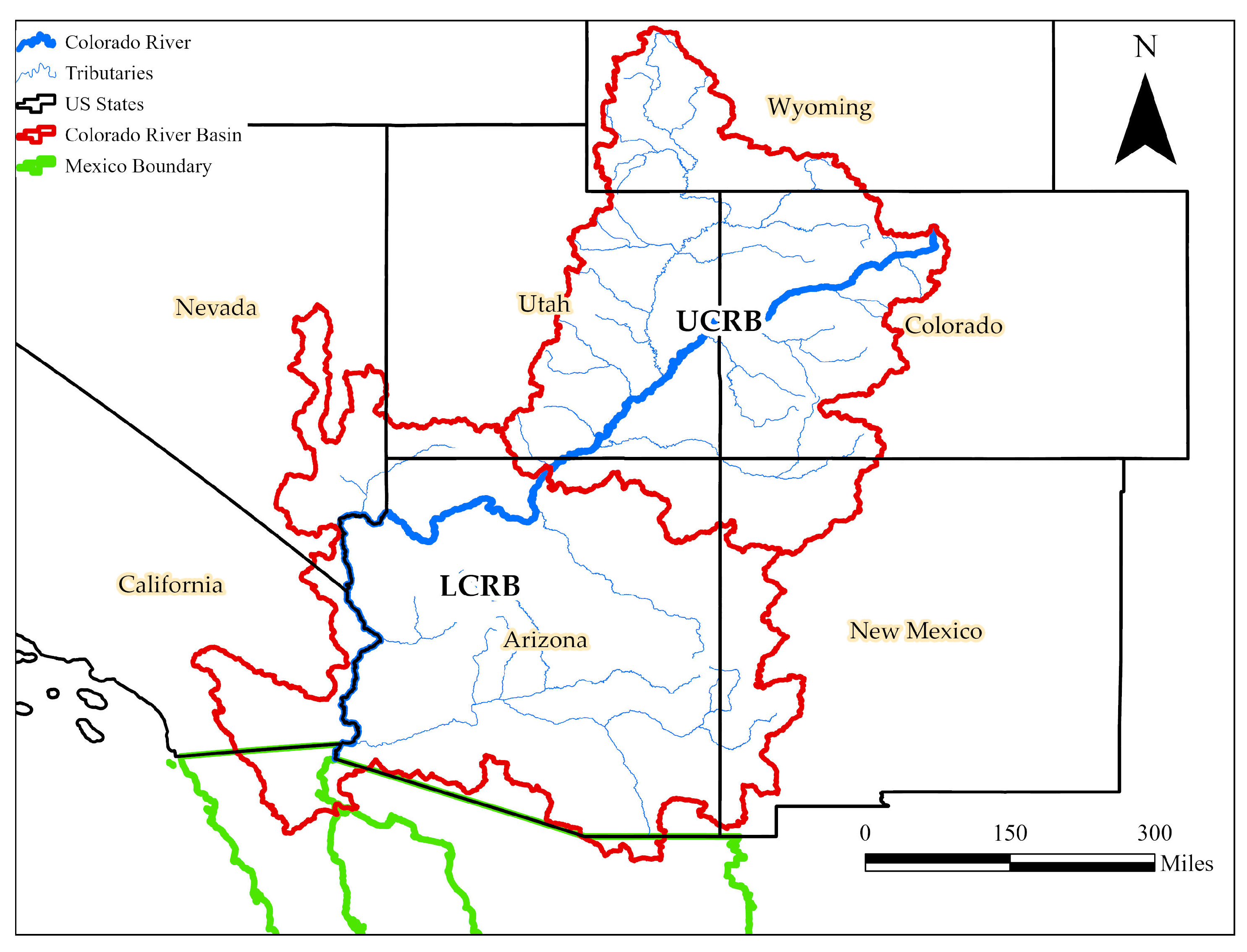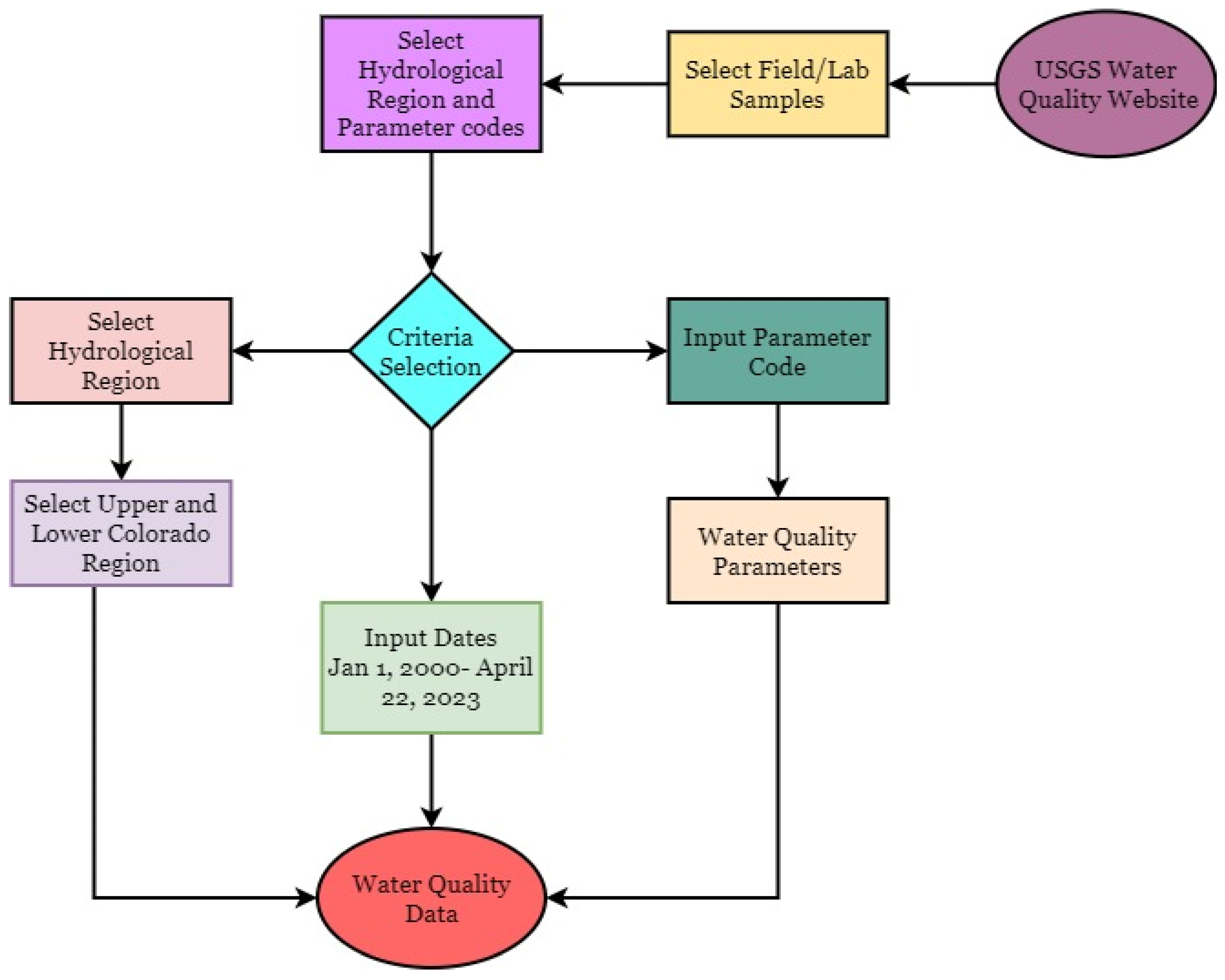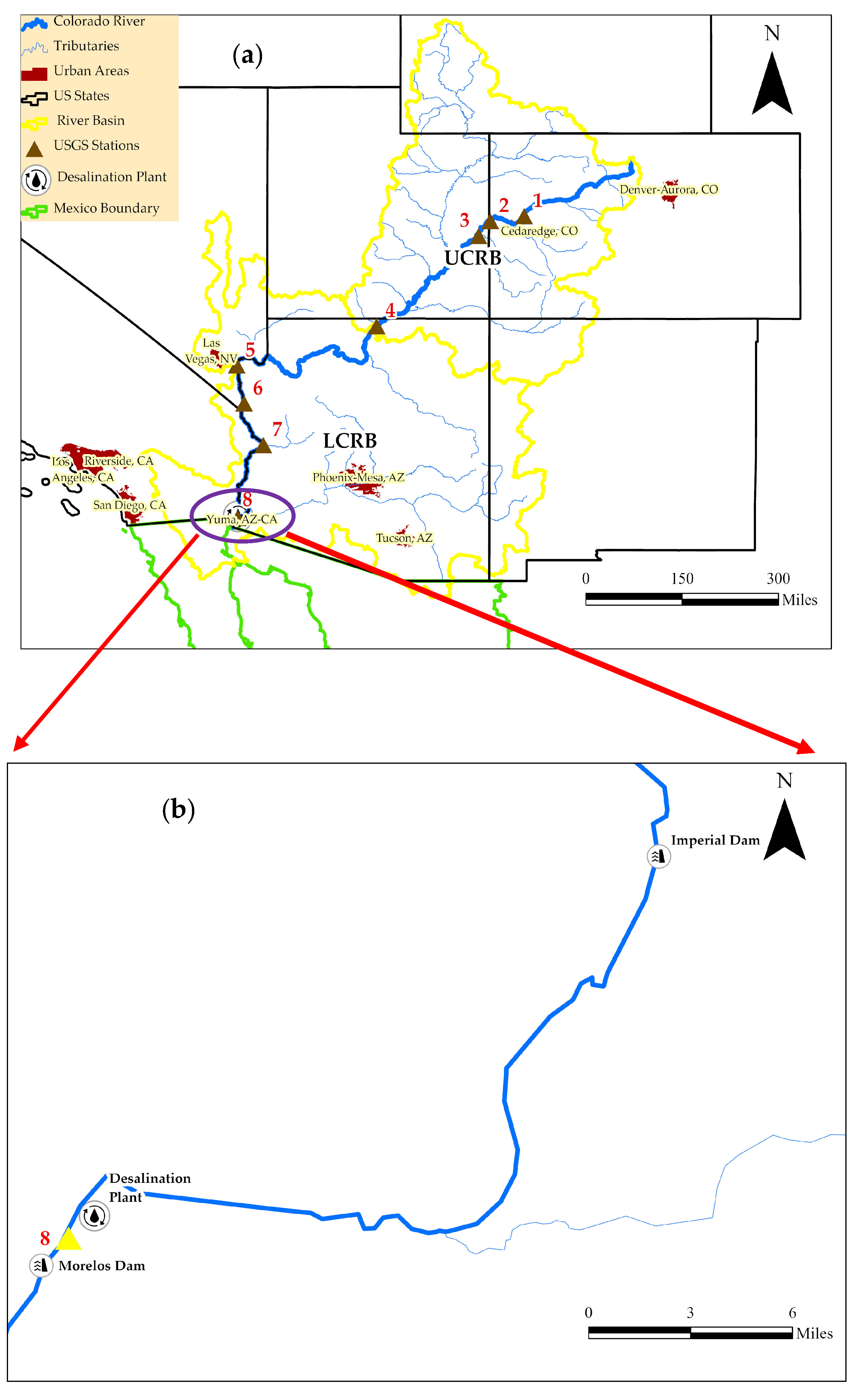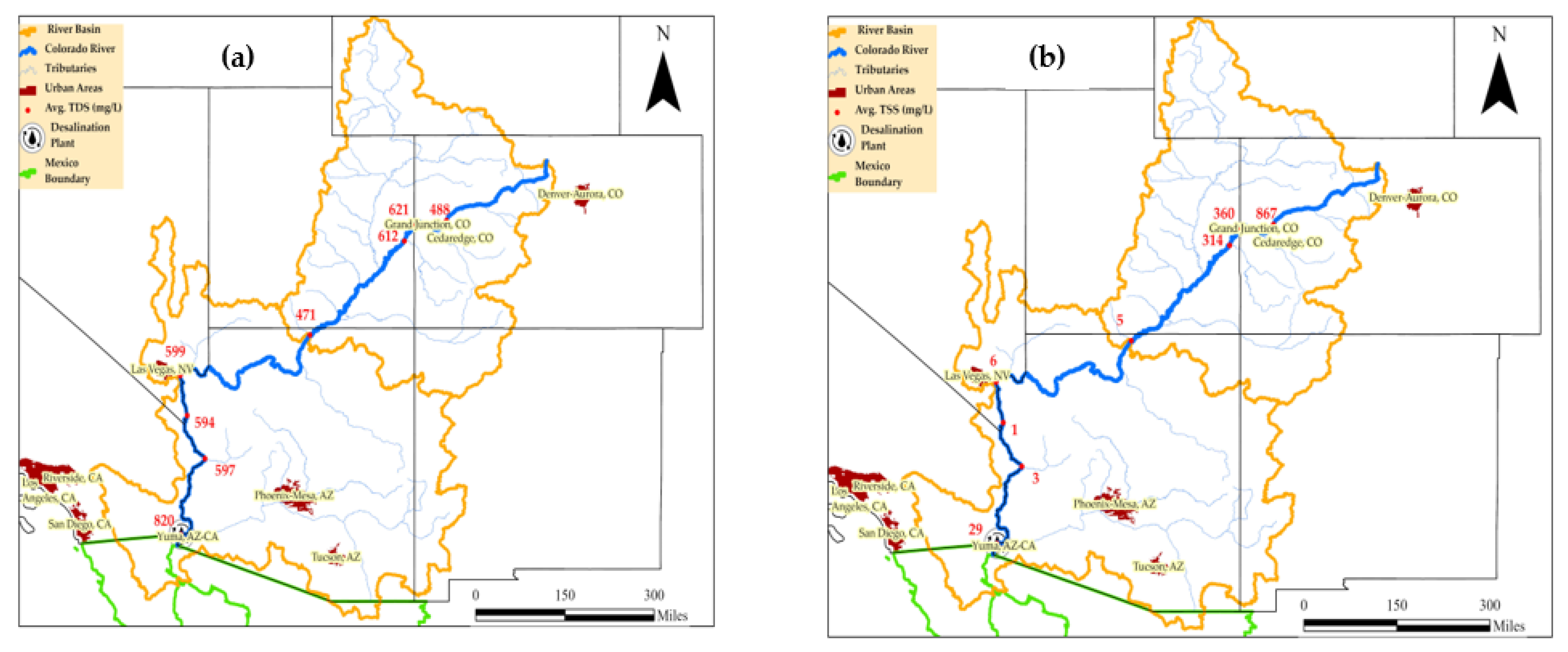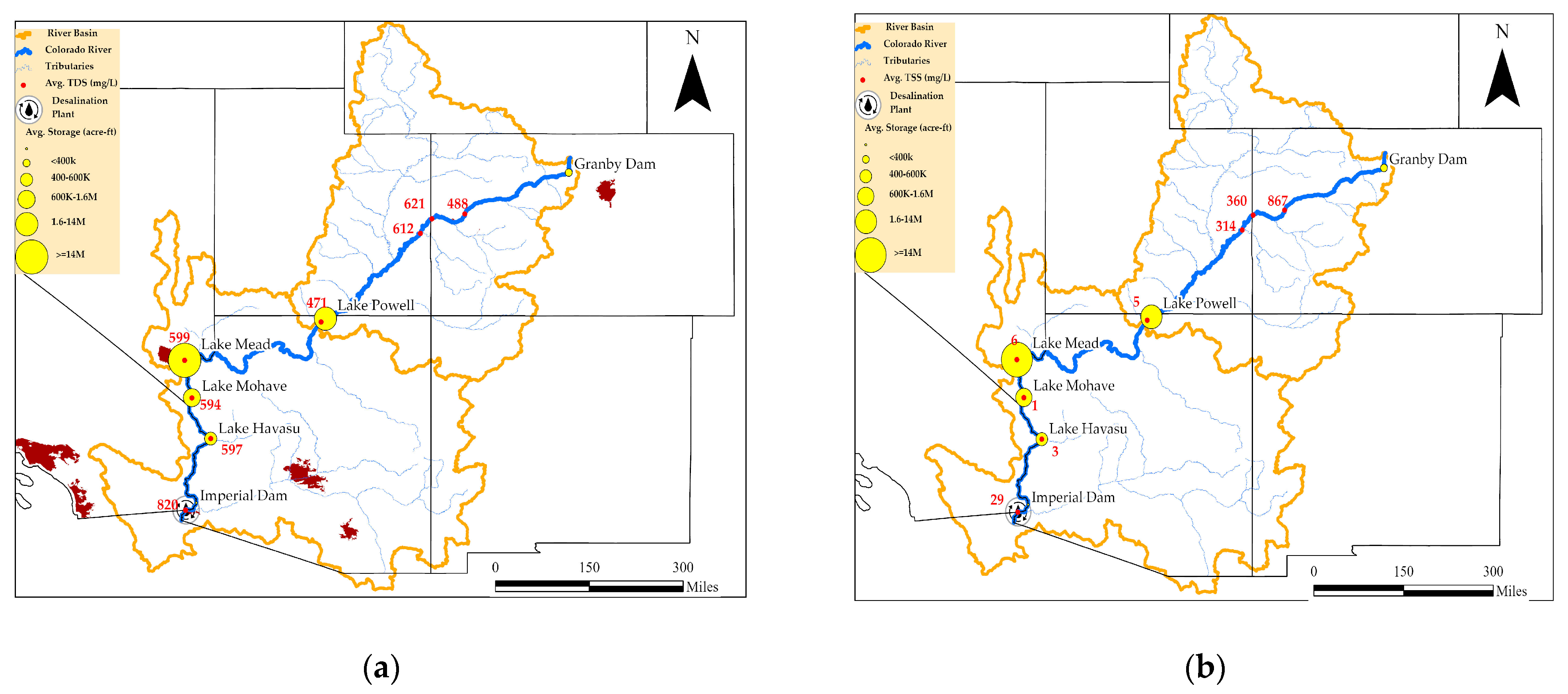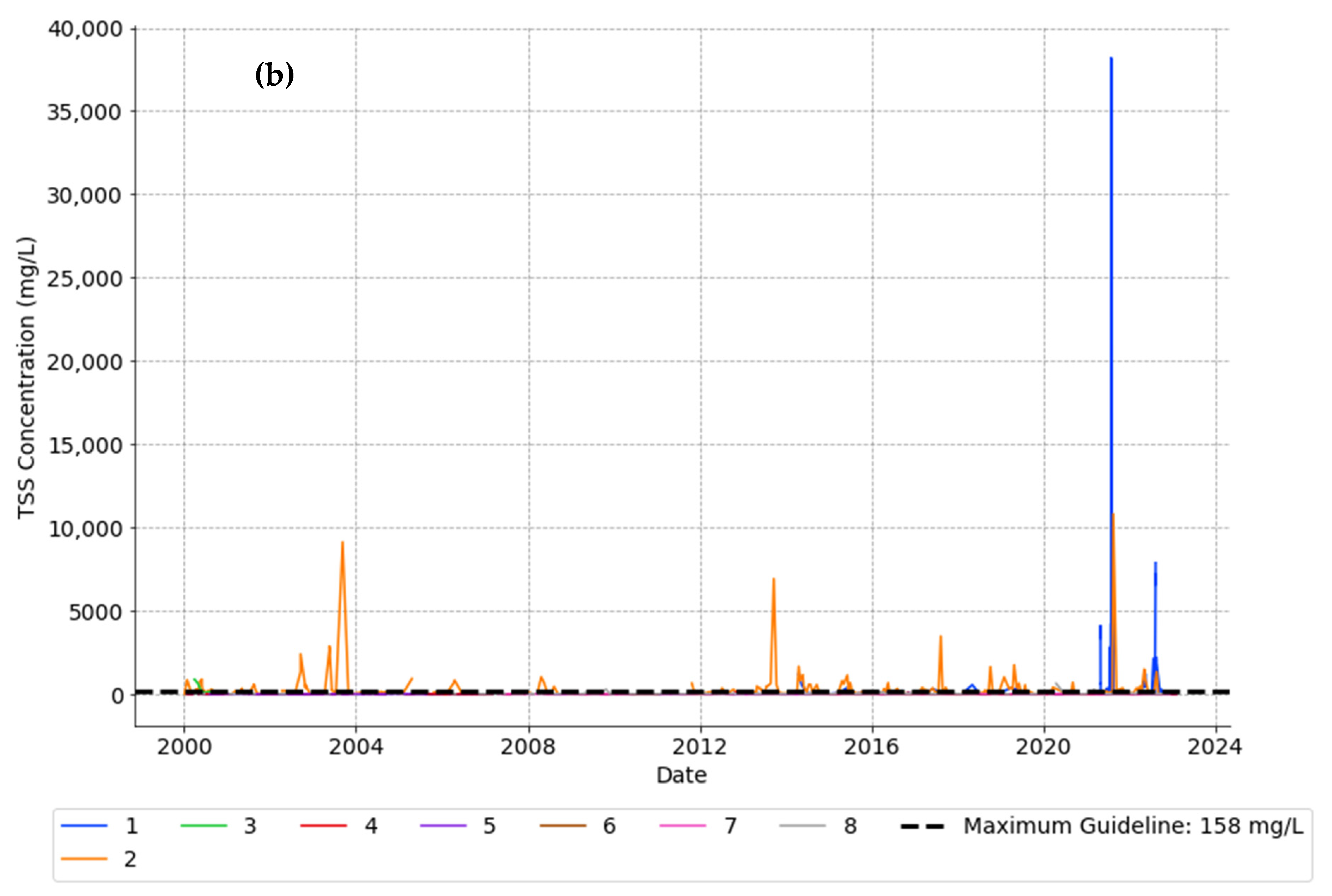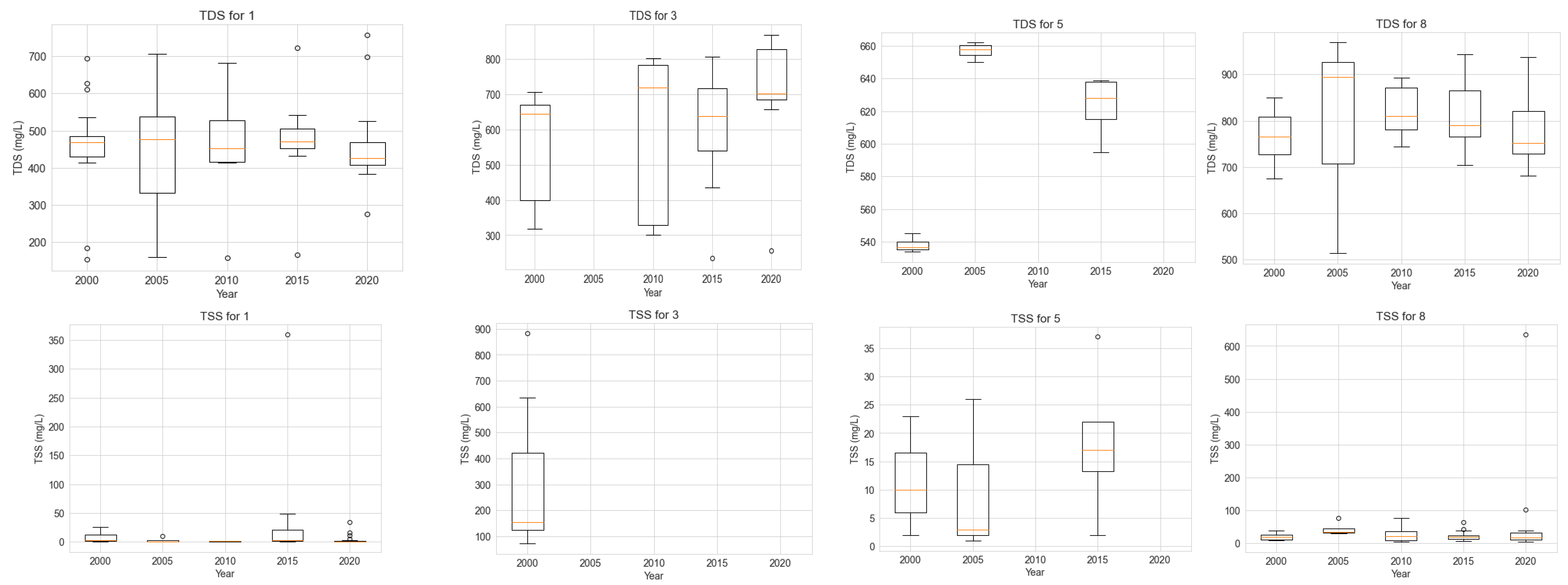1. Introduction
The Colorado River is one of the most crucial water supplies located in the western United States, supporting a range of human endeavors such as domestic, agricultural, and industrial activities. Nevertheless, anthropogenic activities and climate change have significantly altered the river’s water quality, which has caused the degradation of aquatic habitats and the loss of species. The taste, appearance, and safety of the water for human consumption, as well as aquatic life in the river, could be impacted by the elevated levels of TDSs and TSSs [
1,
2,
3]. The Colorado River system’s water quality is most severally impacted by river modifications like dams and irrigation diversions [
4]. Loads generated from non-agricultural regions aided by erosion and dissolution of minerals as water flows through the subsurface of the basin and released into streams as baseflows are contributors to total dissolved solids (TDSs) and total suspended solids (TSSs) in the river [
5]. In recent times, drought events in the Colorado River Basin (CRB) have caught national and international attention underscoring the crucial role that water scarcity plays and its wide-ranging effects. The protracted and extreme drought in the basin resulted in decreasing water availability, declining reservoir levels, and ecological stress. The prolonged drought in the river basin intensifies the challenges caused by climate change and anthropogenic activities [
6].
Continuous drought in the river basin coupled with climate change and anthropogenic activities can lead to an increase in water quality impairment. Climate change and anthropogenic activities such as indiscriminate release of untreated sewage, industrialization, irrigations, application of fertilizers, and grazing around watersheds are potential causes of degradation and impairment of freshwater systems including rivers and lakes [
2,
7,
8,
9,
10,
11,
12]. Freshwater impairment is an issue of great concern affecting the quality of the already stressed water resources, particularly in tropical countries [
13]. Researchers have found that freshwater systems flowing through the Great Plains of Central America are faced with deterioration and threatened the sustainability of biodiversity [
14]. The rise in population and associated activities coupled with the climate changes have resulted in unending stress to the ecology of many waterbodies including rivers. It is, however, difficult to quantify the exact role that climate change has on the impairment of the ecology of water bodies due to the significant influence of nutrients in the waterbodies compared to the slow changes of physical characteristics of the water column [
15]. The impairment of waterbodies such as lakes and rivers affects commercial and recreational activities such as boating, fishing, and swimming which decrease in these waterbodies, which results in huge economic losses [
16]. Drinking contaminated or impaired water exposed to viruses, bacteria, and parasites leads to outbreaks of waterborne diseases. These issues are more prominent in areas with significant agricultural activity and deficient advanced treatment for wastewater and animal and human waste [
17].
Monitoring efforts and management techniques are crucial for preserving and restoring the quality of water resources, and they must be effective to provide the desired outcomes of a healthy waterbody in the ecosystem economy [
18,
19]. To achieve the desired results, it is important to understand the water quality parameters (WQPs) causing impairment and their characterization. In general, these WQPs are categorized as chemical (including cations and anions such as potassium (K
+), sodium(Na
+), Calcium (Ca
2+), magnesium (Mg
2+), chloride (Cl
−), fluoride (F
−) nitrate (NO
3−), and sulfate (SO
42−)), physical (including TSSs, electrical conductivity (EC), dissolved oxygen (DO), and salinity or TDSs), and biological (including total coliforms and
Escherichia coli (
E. coli)) parameters [
1,
2,
20,
21,
22].
This study, however, focuses on the analysis of TDSs, also known as salinity and TSSs, to understand their occurrence and trend in the Colorado River. This will contribute to the development of plans for lowering pollution levels in the river, protecting aquatic ecosystems, and providing a sustainable water supply to communities and states that rely on the river for water. Both TDSs and TSSs are fractional components of the total solids of the same sample separated by filtrations. While TDSs pass through 2.0 µm or less nominal pore size, TSSs are retained on the same sieve size at specific conditions [
23].
The occurrence of these WQPs in the CRB are intensified by several activities including agriculture, mining, irrigation, energy development, and site preparations among others most which of which are unintended consequences which require a holistic and careful approach to minimize them [
24].
The salt in the Colorado River system is abundant and naturally occurring. A significant number of saline sediments in the CRB were deposited in prehistoric marine conditions. Salts contained in sedimentary rocks are readily erodible, dissolved, and discharged into the river system [
25]. In general, the level of salinity in the river increases as it flows downstream with a concentration of about 50 mg/L at its headwaters to about 850 mg/L where it crosses the border between the US and Mexico. On average each year, about nine million tons of salt are carried past the Hoover Dam, which is the uppermost point at which numerical requirements have been established on the river [
25,
26].
The issues of salinity in the river basin cause annual economic damages in a sum exceeding USD 300 million negatively impacting over 36 million people and 4.5 million acres of irrigated lands [
2,
5,
27,
28]. A total of 55% of the dissolved solids in the river basin are accounted for by natural saline springs, natural surface runoff, erosion of saline geologic formations, and groundwater flow. A total of 37% of the salt contributions into the river come from irrigated agricultural lands using both natural and reclaimed wastewater. The remaining 8% of the dissolved solids in the basin are accounted for by evaporative processes and industrial and municipal sources [
27,
29]. The economic damages caused to the river are estimated to rise to USD 471 million annually by the year 2025 according to the US Bureau of Reclamation [
30]. These damages are due to measures put by the US to reduce the TDS load contained in the water discharged to the Republic of Mexico in the international 1944 Water Treaty signed between the two countries [
30]. The treaty stipulates the delivery of 1.8 billion m
3 per year from the Colorado River to the Republic of Mexico in compliance with Minute 242 [
28,
31]. The CRB Salinity Control Act consequently tasks the Secretaries of the US Department of Agriculture (USDA) and the Department of the Interior to ensure the preservation and safeguarding of the water in the Colorado River. Title I of the Act requires the construction, maintenance, and operation of desalting plants, brine discharge canal, and other facilities to ensure the delivery of water to the Republic of Mexico from the Morelos Dam with a concentration of TDSs no more than 115 ± 30 mg/L above the yearly mean annual flow-weighted TDS concentration which arrives at the Imperial Dam (across the California/Arizona border) of the river. The CRB states adopt different numerical values for TDS concentrations of 879, 747, and 723 (concentrations in mg/L), respectively, for locations below the Imperial, Parker, and Hover Dams [
3,
25,
29].
TSSs consist of organic and inorganic solids suspended in the water columns used in describing sediment pollution in a water body [
32]. The average tolerance limit of TSSs in water is about 90 mg/L and 13 mg/L, respectively, for fishes and bottom invertebrates [
33]. Only a few states in the US have a numerical criterion set for TSSs with values ranging from 38 to 158 mg/L [
33]. TSSs in the Colorado River are impacted by several factors including forest fires, rainfall, and runoff. The occurrence of forest fire events in the upper part of the lower Virgin River watershed is said to have caused drastic changes in the land use and land cover (LULC) leading to erosion of a considerable number of suspended sediments affecting the TSS concentration in Lake Mead located in the Colorado River. Rainfall and associated runoff caused by climate change may also impact the flow of eroded sediments into the river. Heavy rains may generate runoff, which can transport sediments, silt, and pollutants from the land into the river and raise TSS levels. In addition, high precipitation events can result in higher river flows, which might affect the dilution and transport of TDSs and TSSs [
34].
TSS accumulation in lakes like those on the Colorado River is likely a phenomenon that requires effective systems to be effectively addressed [
35]. Understanding sediment-related issues in freshwater bodies is important as it impacts the quality of the water and subsequently affects the lives of humans and the aquatic ecosystems which depend on these waters for their needs.
TDS and TSS levels in the CRB are influenced by changes in reservoir storage, streamflow, and natural variability in salinity, extraction of energy and mineral resources such as gas, oil, and coal, and agricultural practices. Increased streamflow dilutes the salt in the water. The decline in water level due to evaporation leads to drought in the river and could potentially increase the level of salt in the water. The variations in TDSs and TSSs are strongly influenced by climatic fluctuations in rainfall and snowmelt runoff. Downstream rivers’ water quality variability is changed by reservoir storage. Large reservoirs, such as Lake Powell in the CRB, selectively route less salty water while storing more salty water when flows are low. When inflows start to rise, poor water quality is then released [
26,
29,
36]. TDSs and TSSs related in the basin could not only impair the quality of water in the river basin but also reduce the capacity of reservoirs such as Lake Mead and Lake Powell in the basin for water storage as well as posing operations challenges to the management of the reservoirs in the basin. At the time of their inception, reservoirs had a known amount of water storage capacity. This is however reduced by the mechanism of siltation of the reservoirs by sediments in reservoirs which disrupt the continuous movement of sediments through rivers [
37,
38]. Sedimentations in reservoirs could lead to reduce usable life and deprives the downstream sections of the river of required sediments necessary for sustenance of aquatic habitats [
6,
38].
TDS concentrations have a direct impact on groundwater and river bodies worldwide. A high concentration of TDSs has the potential to cause toxicity in aquatic organisms. Changes in the ionic compositions of water and the toxicity of the ions can elevate the salinity of the water which can cause shifts in biotic communities hence limiting their biodiversity [
39]. TSSs on the other hand impede light penetration into lower water layers and hence have the potential to cause shallow lakes and bays to silt and smother benthic habitats as they impact both living organisms and eggs. As particles of clay, silt, and other organic materials settle at the bottom of shallow lakes and bays, they have the potential to cause the suffocation of newly hatched larvae and impede the survival of zoobenthos [
40]. The presence of TSSs in the water also affects the amount of light that penetrates through the water column which restricts the rate of energy assimilation by benthic algae, macrophytes, and phytoplankton [
40]. Improved quantification of TSS and TDS loadings in streams could be useful to assess the possible impacts of urbanized activities such as mining [
36]. A TDS/TSS ratio has been proposed as a method for estimating TDS loading using TSSs as an indicator in past studies [
36]. Reduction in the biodiversity abundance of aquatic animals in rivers in the North American Great Plains has been linked to changes in hydrology, fragmentation of habitats, and increased concentration of TDSs and TSSs due to associated climate and LULC or landscape use changes [
14]. The topography, soil types, and vegetation cover of a local landscape can impact the pace of erosion and sediment transport. The landscape steep slopes and bare and erodible soils can facilitate soil erosion leading to increment in the TSS levels in the river. Studies have found that an increase in sediment loads leads to a decrease in dissolved oxygen which cause affects the development of fish species [
14].
Effective monitoring of these WQPs requires a multifaceted approach as no single known approach could efficiently reduce the number of sediments and dissolved solids in one single waterbody. Studies have shown that measures put in place to reduce sediments in the Colorado River could also be beneficial to the reduction of TDSs but only along the reach of the river. Reductions in TSSs could not improve the TDS concentration in tributaries to the Colorado River except for the lower Gunnison and Roaring Fork Rivers [
41].
Actions taken to reduce the amount of TSSs and TDSs in the CRB include instituting a water quality control plan to protect and enhance the quality of water in the basin, construction of sediment control measures and best management practices including check dams, erosion control blankets, sediment ponds and traps, and silt fences to contain sediments and prevent their transport during construction works, the implementation of a management plan for non-point source pollution, and instituting salinity control measures by collaborative efforts of the Bureau of Reclamation, Bureau of Land Management, the Basin States Program, and the United States Department of Agriculture (USDA) [
25,
42,
43].
The effectiveness of the management and monitoring efforts of the water systems including rivers and lakes however largely depends on these spatiotemporal changes in the status of these water systems that reflect natural and human activities in the surrounding ecosystems hence the need to carry out this study to understand and provide managers of the river system with insights on the trend of these WQPs in the Colorado River to improve water management practices and to a large extent take measures to ensure the sustainability of the river as a significant source of water for the western US and the Republic of Mexico.
The objective of this study is to analyze the spatiotemporal variations in WQPs specifically TDS and TSS concentrations along the Colorado River. We hypothesized that there is a significant variation in TDS and TSS concentrations along the Colorado River and that the reservoir storage influences the concentrations of these WQPs.
The study subsequently addresses the following questions aimed at achieving the objective:
How do the concentrations of TDSs and TSSs vary spatiotemporally along the Colorado River?
How do changes in seasons influence the levels of TDSs and TSSs in the Colorado River?
Is there a statistically significant difference in the TDS and TSS concentrations in the Colorado River in the Upper Colorado River Basin (UCRB) and the Lower Colorado River Basin (LCRB)?
4. Conclusions
The study aimed to assess the spatiotemporal trends of TDSs and TSSs along the Colorado River, which is a major source of water to the western US and the Republic of Mexico with its headwaters originating from the Rocky Mountains in Colorado and running into its terminus at the northern part of the Gulf of California. The analysis conducted shows that the TDS concentration was significantly higher in the UCRB while the LCRB shows a generally high level of TSS. We found that the activities in these two basins are distinctive and may be a factor in these variations. While the UCRB is characterized by mountainous terrain producing large amounts of snow melt and an increase in agriculture, mining, and energy development activities, the LCRB is made of several large reservoirs including Lake Mead and Lake Powell with huge storage which have the potential to effectively dilute the effects of dissolved salts. These reservoirs, however, experienced large evaporations during the summertime which plays significant impacts on their TDS level. The byproducts of agriculture and mining practices such as sediments and fertilizers are transported and deposited in the river during rainfall and snowmelt, increasing the level of TSSs particularly in the UCRB. Additionally, TSSs in the river basin are increased by natural erosion from neighboring watersheds which are aided by slope steepness and the LULC of the region as well as channel and streambank erosion of the river basin.
The study also examines the statistical significance of these WQPs within and across months, seasons, and years and between the basins using the Kruskal–Wallis test. Results from the significance test show there are statistically significant differences in TDSs and TSSs from month to month, season to season, and year to year. We suspect that these significant variations are largely due to the prolong drought in the basin leading to seasonal rises in consumptive use as well as agriculture practices, snowmelt runoff, and evaporation rates exacerbated by increased temperature in the summer months [
31,
47,
79]. It is however worth noting that the Kruskal–Wallis test is unable to identify the locations of the occurrence of stochastic dominance in the levels of TDSs and TSSs.
In summary, this study presents detailed findings in understanding the spatiotemporal variability of the TDS and TSS concentration along the Colorado River which can help water management and conservation authorities to develop efficient strategies to lessen the detrimental effects of prolonged drought, natural variations such as precipitation, snowmelts, and runoff, and anthropogenic activities on the basin’s water quality. Further research may examine the relationship between TDS and TSS concentrations and other WQPs to gain more knowledge about the overall condition of the river ecosystem. Additional research will need to be conducted to quantify the effect of flowrates, precipitation, LULC, channel modifications, and evaporation on the overall changes TDS and TSS concentration in the river system.

